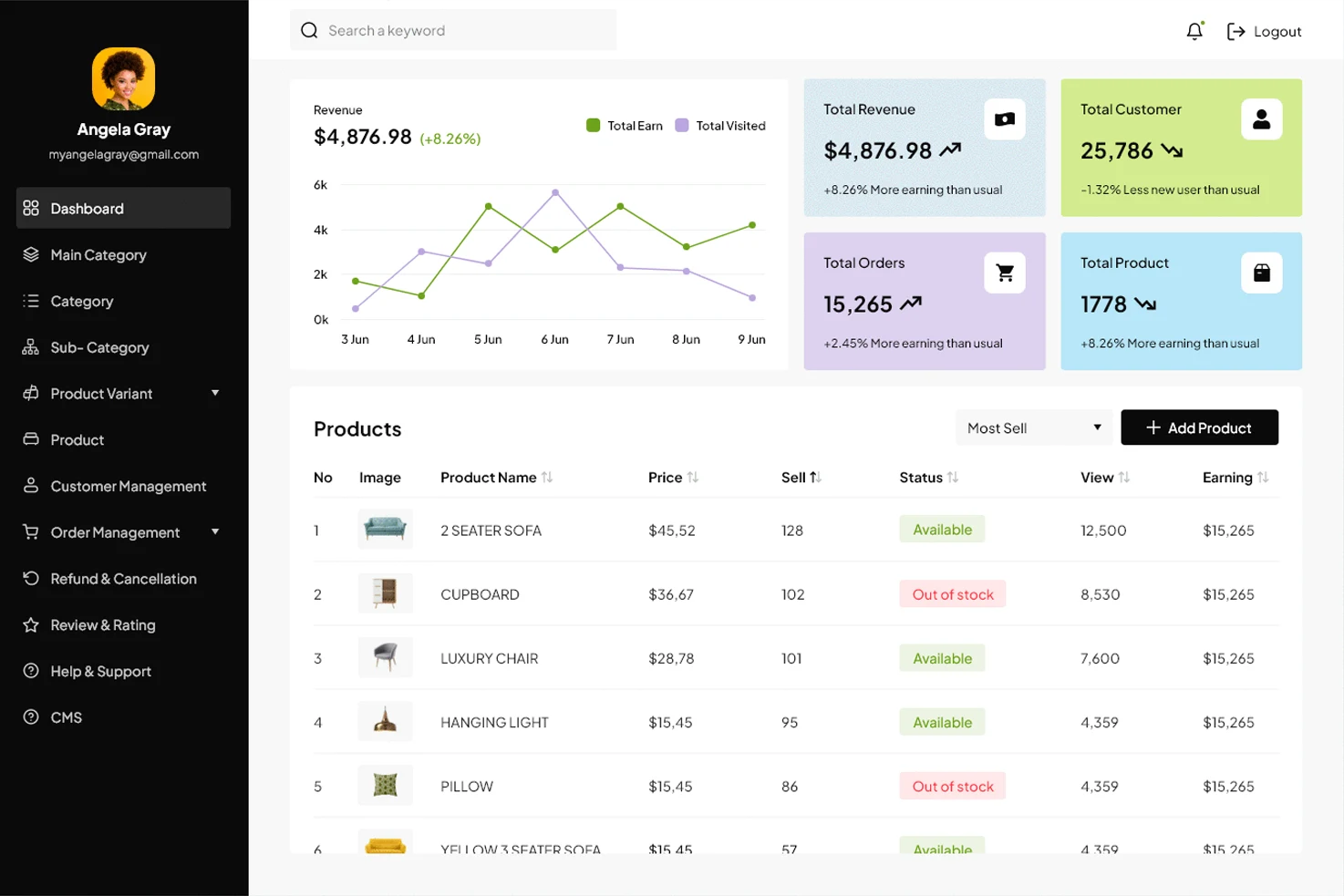Transforming HR Operations with a SaaS-Based Human Resource Management System (HRMS)
- Retail
An Enterprise Resource Planning (ERP) software was implemented to streamline operations and address the pressing challenges faced by the world’s largest furniture retailer. The system enabled real-time tracking of inventory levels, providing accurate data to prevent stockouts and overstock situations, ensuring the retailer could continue to grow and innovate while maintaining operational efficiency.
A global furniture retailer, founded in the 1940s, established a strong presence in Europe and began expanding into North America, Asia, and other parts of the world. Over the decades, it has grown from a small local shop into a global powerhouse, offering everything from stylish furniture, home accessories to lifestyle products. Today, the company operates over 400 stores in more than 50 countries and serves millions of customers each year through both physical locations and a growing e-commerce platform.
Implementation of a centralized inventory management system covering all warehouses, distribution centers, retail stores, and real-time inventory tracking.
Product information management (PIM) enabling retailers to easily sell products on multiple platforms instead of creating and maintaining listings on other sites.
Cloud-based financial management systems embed intelligent technologies like advanced AI, machine learning, and blockchain directly in managing all business accounting procedures such as cash flow management, general ledger, etc.
Relational databases like MySQL, PostgreSQL, Microsoft SQL Server are commonly used for storing and managing structured data.
Jenkins, GitLab CI/CD, or CircleCI facilitate automated testing, deployment, and data monitoring.
Power BI, Tableau, or Looker integration to provide real-time analytics and reporting on order data.
MuleSoft or IBM Integration Bus help integrate and manage data flow between different applications within the ERP, ensuring seamless connectivity.

As the company scaled its operations globally, several key challenges emerged while managing customer onboarding, product availability, and marketing efforts across numerous stores.
25% reduction in inventory costs through accurate demand forecasting.
30% improvement in supply chain efficiency through real-time monitoring and automation.
20% increase in sales through data-driven decision-making and enhanced customer experience.
| Milestone | Tasks | Timeline | Responsible |
|---|---|---|---|
| Project Initiation | – Define project scope and objectives | Month 1 | Project Manager |
| – Stakeholder identification and engagement | Month 1 | Project Manager | |
| – Develop project plan and timelines | Month 1 | Project Manager | |
| – Resource allocation and team formation | Month 1 | HR, Project Manager | |
| – Kick-off meeting with stakeholders | Month 1 | Project Manager, Stakeholders | |
| Requirements Gathering | – Conduct business process analysis | Month 2 | Business Analysts |
| – Gather functional and technical requirements | Month 2 – 3 | Business Analysts, IT Team | |
| – Document requirements and get stakeholder approval | Month 3 | Business Analysts, Stakeholders | |
| System Design | Design system architecture using Microservices, Containerization (Docker), and API Management | Month 3 – 4 | Solution Architect, IT Team |
| Develop data models and database schema using SQL/NoSQL Databases | Month 4 | Database Administrator (DBA) | |
| – Design user interfaces (UI/UX) with Web/Mobile Development Frameworks (React, Angular, Flutter) | Month 4 – 5 | UI/UX Designers | |
| – Plan integration with existing systems using Middleware and Integration Technologies | Month 5 | Solution Architect, IT Team | |
| – Security and compliance design with Encryption, IAM, and Compliance Tools | Month 5 | Security Team, Compliance Team | |
| Development | – Set up development environment using DevOps tools (Jenkins, GitLab CI/CD) | Month 5 | DevOps Team |
| – Develop core ERP modules (Order Management, Inventory, Finance) using Backend Frameworks (Spring Boot, Django) | Month 5 – 8 | Development Team | |
| – Develop supply chain and inventory management features using Cloud Platforms (Azure) | Month 6 – 9 | Development Team | |
| – Implement data integration and migration tools using ETL Tools and Message Queues (RabbitMQ, Kafka) | Month 6 – 9 | IT Team, DBA | |
| – Develop customizations and extensions using Microservices and APIs | Month 7 – 9 | Development Team | |
| Testing and Quality Assurance | – Unit testing of individual modules using Automated Testing Tools | Month 7 – 9 | Development Team, QA Team |
| – Integration testing with API and Integration Tools | Month 8 – 10 | QA Team | |
| – User acceptance testing (UAT) | Month 9 – 10 | QA Team, Business Users | |
| – Performance and load testing using Performance Testing Tools | Month 10 | QA Team | |
| Training and Documentation | – Develop user manuals and documentation | Month 9 – 11 | Documentation Team |
| – Conduct training sessions for end-users with Training Management Systems | Month 10 – 11 | Training Team, IT Team | |
| – Provide admin and technical training | Month 10 – 11 | IT Team, Solution Architect | |
| Deployment and Go-Live | – Final data migration and system configuration using Data Migration Tools | Month 11 | IT Team, DBA |
| – Go-live planning and preparation | Month 11 | Project Manager, IT Team | |
| – Post-go-live support using Monitoring and Logging Tools (Kubernetes, ELK Stack) | Month 12 – 13 | IT Support Team | |
| Post-Implementation Review | – Monitor system performance and gather feedback | Month 13 | Project Manager, IT Team |
| – Conduct a post-implementation review and lessons learned session | Month 13 – 14 | Project Manager, Stakeholders | |
| – Finalize project closure report | Month 14 | Project Manager |